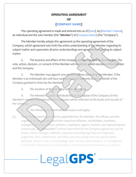Do Pet Sitters Need a Client Liability Waiver?
Picture this: You’re a pet sitter walking a client’s energetic Labrador when it suddenly bolts, causing a neighbor’s fence to collapse. The client...
6 min read
LegalGPS : May. 23, 2025
Imagine this: You’re a personal trainer leading a high-energy HIIT session. A client pushes too hard, sprains their ankle, and suddenly you’re facing a $15,000 lawsuit for “negligence.” Your heart sinks—could this end your business? Scenarios like this are why every fitness trainer needs a liability waiver. This simple document can shield you from financial ruin, protect your reputation, and let you focus on what you love: helping clients crush their fitness goals.


Legal GPS Pro
Protect your business with our complete legal subscription service, designed by top startup attorneys.
But do you really need a liability waiver for fitness training clients? In a word, yes. Whether you’re a solo trainer, group class instructor, or gym owner, a waiver is your first line of defense against the inherent risks of physical training. In this guide, we’ll break down what a liability waiver is, why it’s non-negotiable for fitness professionals, the key elements to include, when to use one, and how to create your own. Packed with real-world examples and actionable pro tips, this post will equip you to safeguard your fitness business with confidence. Let’s get started.
A liability waiver is a legal document that clients sign to acknowledge the risks of fitness activities and agree not to sue you for injuries or damages that may occur. It’s not a blanket shield—it won’t protect against gross negligence—but it significantly reduces your liability for common risks like muscle strains, minor accidents, or equipment mishaps. For fitness trainers, whose work involves physical exertion and unpredictable client behavior, a waiver is as essential as a good pair of training shoes.
Without a liability waiver for fitness training clients, you’re exposed to lawsuits that could drain your savings or shutter your business. Even if you win a lawsuit, legal fees can cost thousands. Beyond financial protection, a waiver sets clear expectations, showing clients you’re a professional who prioritizes safety and transparency. It’s a small step that delivers massive peace of mind.
Meet Alex, a personal trainer who runs one-on-one sessions at a local gym. During a kettlebell workout, a client twists their knee and sues Alex for $10,000 in medical bills, claiming improper instruction. Alex had no signed waiver, so he spends months and thousands in legal fees defending himself, even though the injury was due to the client’s poor form. If Alex had used a liability waiver, the client’s signed acknowledgment of risks could have dismissed the lawsuit early, saving him time, money, and stress.
Don’t start from scratch. A customizable liability waiver template from Legal GPS ensures your waiver is legally sound and tailored for fitness trainers. These attorney-drafted templates cover all the essentials, saving you time and reducing the risk of costly oversights.
A strong fitness trainer liability waiver isn’t just a formality—it’s your shield against unexpected legal battles. Here are the must-have elements to include:
These elements address the biggest risks fitness trainers face, from minor injuries to complex legal claims. Be sure to check state-specific requirements, as some states have stricter rules for waivers (e.g., requiring clear language or specific formatting).
Sarah owns a small gym offering group yoga classes. She verbally explains the risks of yoga but doesn’t require signed waivers. When a client pulls a muscle and sues for $5,000, claiming Sarah didn’t warn them about strain risks, she has no documentation to prove the client was informed. A signed waiver with a clear assumption of risk clause would have protected Sarah by showing the client knowingly accepted the risks.
Add a medical disclosure section to your waiver, requiring clients to list conditions like asthma, joint issues, or heart problems. This helps you design safe workouts and strengthens your defense if a client claims you ignored their health needs.
You might think waivers are only for high-risk activities like CrossFit or weightlifting, but that’s a myth. A liability waiver for fitness training clients is critical in these scenarios:


Legal GPS Pro
Protect your business with our complete legal subscription service, designed by top startup attorneys.

Waiver and Release for Fitness Instruction
Download our Fitness Instruction Waiver Template to maximize safety and minimize liability in your fitness business. Simple and comprehensive.
Trusted by 1,000+ businesses to safeguard their LLCs.
Some trainers believe myths like “Insurance covers everything” or “Waivers aren’t needed for low-risk activities like stretching.” In reality, insurance may not cover all claims, and even low-risk sessions can lead to lawsuits. Waivers also boost client trust by showing you’re proactive about safety, making them more likely to stick with you.
Jake runs outdoor bootcamps in a city park. During a session, a client trips on uneven grass and sues for $7,500, alleging Jake didn’t ensure a safe environment. Jake’s liability waiver, signed by all participants, includes an assumption of risk clause for outdoor conditions. The court dismisses the lawsuit, as the client acknowledged the risks of uneven terrain.
Make waivers mandatory for every client, even for free trials, consultations, or “light” sessions. A consistent policy ensures you’re protected from day one and sets a professional tone for your business.
Creating a fitness client waiver is easier than you think. Follow these steps to get started:
When presenting the waiver, avoid scaring clients. Say something like, “This waiver ensures we’re both protected so we can focus on your fitness goals.” This frames it as a win-win.
Emma, a group fitness instructor, switched to digital waivers for her spin classes. She emails a Legal GPS waiver template to clients before their first session, using DocuSign for signatures. A new client is impressed by her organized process and refers three friends, boosting Emma’s business. The waiver protects her legally and enhances her professional reputation.
Use e-signature tools like DocuSign or HelloSign to collect waivers quickly and store them securely. Digital records are easy to access for tax season or legal disputes, saving you from paper clutter.
Even well-meaning trainers can trip up with waivers. Here are common mistakes and how to dodge them:
Legal GPS templates are designed with clear, state-specific language to avoid these pitfalls, but always review your waiver annually or when expanding services.
Tom, a gym owner, uses a waiver from 2018 that doesn’t include his new TRX classes or comply with his state’s updated waiver laws. When a client sues after a TRX injury, the court rules the waiver unenforceable, leaving Tom liable for $12,000. An updated, state-compliant waiver would have protected him.
Combine your waiver with general liability insurance to cover scenarios where waivers don’t apply, like gross negligence or equipment failure. This layered approach maximizes your protection.
A liability waiver for fitness training clients is more than a formality—it’s a lifeline for your business. By clarifying risks, limiting liability, and setting professional expectations, it protects you from lawsuits, financial loss, and reputation damage. Whether you’re leading one-on-one sessions, group classes, or running a gym, a waiver ensures you can focus on transforming lives, not fighting legal battles.
Ready to protect your fitness business? Explore Legal GPS’s fitness waiver templates for a fast, affordable way to create enforceable waivers tailored to your needs. Want more legal tips? Check out our related blogs on “How to Set Up a Fitness Business Legally” or “Protecting Your Gym from Client Disputes” to keep your business thriving. Sign up for our newsletter or download a template today to train with confidence.
The biggest question now is, "Do you need a lawyer for your business?” For most businesses and in most cases, you don't need a lawyer to start your business. Instead, many business owners rely on Legal GPS Pro to help with legal issues.
Legal GPS Pro is your All-In-One Legal Toolkit for Businesses. Developed by top startup attorneys, Pro gives you access to 100+ expertly crafted templates including operating agreements, NDAs, and service agreements, and an interactive platform. All designed to protect your company and set it up for lasting success.

Legal GPS Pro
Protect your business with our complete legal subscription service, designed by top startup attorneys.
|
Premium Template
Single-use Template |
Legal GPS Pro
Unlimited Access, Best Value |
|
|
| Choose Template | Learn More |
| Trusted by 1000+ businesses | |
Table of Contents

Picture this: You’re a pet sitter walking a client’s energetic Labrador when it suddenly bolts, causing a neighbor’s fence to collapse. The client...

Picture this: You’re a photographer wrapping up a stunning brand shoot for a local business. The images are perfect, and the client uses them in a...

You’ve just delivered a 15,000-word translation of a legal contract, expecting prompt payment for weeks of meticulous work. Instead, the client...